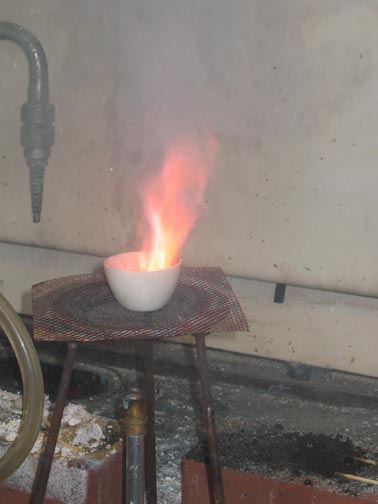Explosions as the epitome of spontaneity
 A variety of gun powder mixtures are ignited to demonstrate the concept of "spontaneity."
A variety of gun powder mixtures are ignited to demonstrate the concept of "spontaneity."
Ingredients: potassium nitrate, charcoal, sulfur
Procedure: A complete recipe follows.
1. Prepare a fine powder of potassium nitrate "salt peter" using a mortar and pestle.
2. Combine the salt peter, charcoal, and sulfur in the ratio 75:15:10.
3. Gently and thoroughly mix the composition on a sheet of paper. Achtung! Do not grind or sift the mixture!
4. Carefully ignite a small quantity and observe the reaction.
Understanding: The history of the development of black powder is a long and rich one. It is a history that must be appreciated to understand the world as we know it today.
The overall reaction of black powder is a reduction/oxidation reaction that is highly exothermic and produces significant quantities of gas
2 KNO3(s) + 3 C(s) + S(s) → K2S(s) + 3 CO2(g) + N2(g)
The heat of reaction for the explosion of black powder is 2.12 kJ per gram of black powder. The thick white smoke that is produced as a product of the reaction is potassium sulfide. Note that with this ratio of salt peter, charcoal, and sulfur, the reaction requires no atmospheric oxygen and can proceed in aerobic or anaerobic environments.When black powder was used in combat, the white smoke of potassium sulfide was thick and irritating. There was a strong interest in creating an explosive with the pow of black powder, but with smokeless reaction products. A number of smokeless powders were created. A notable one is nitrocellulose. Another example of a smokeless explosive powder is the 12:7:3 ratio of potassium permanganate, aluminum, and sulfur
6 KMnO4(s) + 14 Al(s) → 3 K2O(s) + 7 Al2O3(s) + 6 Mn(s)
The sulfur acts to significantly reduce the ignition temperature through the reactionS(s) + O2(g) → SO2(g)
Exploring the chemistry of other flash compounds
Question: Flash powders can be made from a variety of combinations of (1) a strong oxidizing compound, such as nitrates, chlorates, perchlorates, and permanganates, and (2) a metal to be oxidized, such as aluminum or magnesium. For the following flash powders, write the balanced chemical reaction.A combination of potassium nitrate, KNO3, and magnesium powder. The products include magnesium oxide and potassium oxide. A combination of potassium chlorate, KClO3, and aluminum powder. The products include potassium chloride. A combination of potassium perchlorate, KClO4, and aluminum powder. The products include potassium chloride.
You can check your answers here.